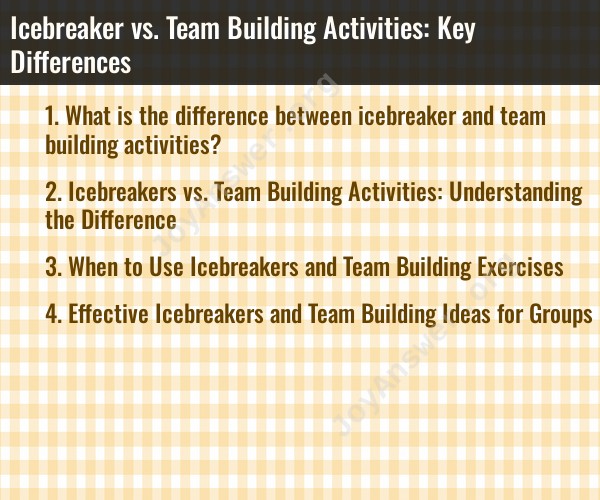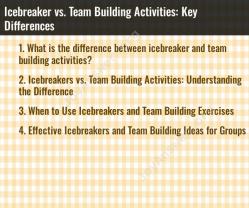What is the difference between icebreaker and team building activities?
Icebreakers and team building activities are both used in group settings, such as meetings, workshops, and team-building events, to foster interaction and engagement among participants. However, they serve different purposes and have distinct characteristics:
Icebreakers:
- Purpose: Icebreakers are designed to introduce participants to each other, create a comfortable and relaxed atmosphere, and help break down initial barriers and shyness. They are typically used at the beginning of a meeting or event to warm up the group and encourage social interaction.
- Timing: Icebreakers are typically short and concise activities that can be completed in a relatively short amount of time, often within the first few minutes of a meeting.
- Activities: Icebreakers often involve simple, fun, and lighthearted activities or questions. Examples include two truths and a lie, name games, or quick group discussions on non-work-related topics.
- Goal: The primary goal of icebreakers is to help participants get to know each other, establish rapport, and create a comfortable environment for more meaningful discussions or activities later in the meeting or event.
Team Building Activities:
- Purpose: Team building activities are designed to promote collaboration, trust, and teamwork within a group. They are often used to improve communication, problem-solving skills, and overall group cohesion. Team building activities can be used at various points during a meeting, workshop, or event.
- Timing: Team building activities can vary in length and complexity. Some are short and can be integrated into a meeting or training session, while others may require more time and are conducted as stand-alone events.
- Activities: Team building activities come in many forms, including problem-solving exercises, trust-building exercises, outdoor challenges, and more. These activities often require participants to work together to achieve a common goal.
- Goal: The primary goal of team building activities is to strengthen the bonds and relationships among group members, improve their ability to work together effectively, and enhance overall team performance.
In summary, the key difference between icebreakers and team building activities lies in their intended purposes and timing. Icebreakers are focused on initially breaking down social barriers and establishing a comfortable atmosphere, while team building activities are aimed at developing collaboration and teamwork skills among group members. Both types of activities can be valuable in different contexts, depending on the goals and needs of the group.
Icebreakers vs. Team Building Activities: Understanding the Difference
Icebreakers and team building activities are both important tools for building rapport and trust among team members. However, there is a key difference between the two.
Icebreakers are short, simple activities that are designed to help people get to know each other and feel comfortable working together. They are often used at the beginning of meetings or workshops to break the ice and create a more relaxed atmosphere.
Team building activities are more complex and in-depth activities that are designed to help teams improve their communication, collaboration, and problem-solving skills. They are often used over a series of sessions to help teams develop into high-performing units.
When to Use Icebreakers and Team Building Exercises
Icebreakers are appropriate for a variety of situations, such as:
- The beginning of a new meeting or workshop
- After a period of time when team members have not worked together
- When a new team member joins the team
- When a team is experiencing conflict or tension
Team building exercises are appropriate for situations when:
- A team is new and needs to develop rapport and trust
- A team is struggling to communicate or collaborate effectively
- A team is facing a challenging project or task
- A team is going through a period of change or transition
Effective Icebreakers and Team Building Ideas for Groups
Here are a few examples of effective icebreakers and team building activities for groups:
Icebreakers
- Two Truths and a Lie: Each person shares two truths and one lie about themselves. The other group members have to guess which one is the lie.
- Would You Rather?: This game is a fun way to learn more about people's preferences. The facilitator asks questions like "Would you rather be able to fly or be invisible?" and the group members have to choose which option they would prefer.
- Human Bingo: Each person gets a bingo card with different characteristics on it, such as "speaks more than one language" or "has traveled to more than three countries." The group members have to move around the room and talk to each other to find someone who matches each characteristic.
Team Building Activities
- Escape Room: Escape rooms are a fun and challenging way for teams to work together to solve puzzles and escape from a locked room.
- Ropes Course: Ropes courses are a great way for teams to build trust and communication skills. They involve working together to complete a series of obstacles, such as climbing walls and crossing zip lines.
- Problem-Solving Exercises: There are a variety of problem-solving exercises that can be used for team building. For example, the facilitator can give the team a specific task to complete, such as building a bridge out of toothpicks and marshmallows.
When choosing an icebreaker or team building activity, it is important to consider the size of the group, the time available, and the specific needs of the team. It is also important to make sure that the activity is appropriate for the age and maturity level of the participants.




